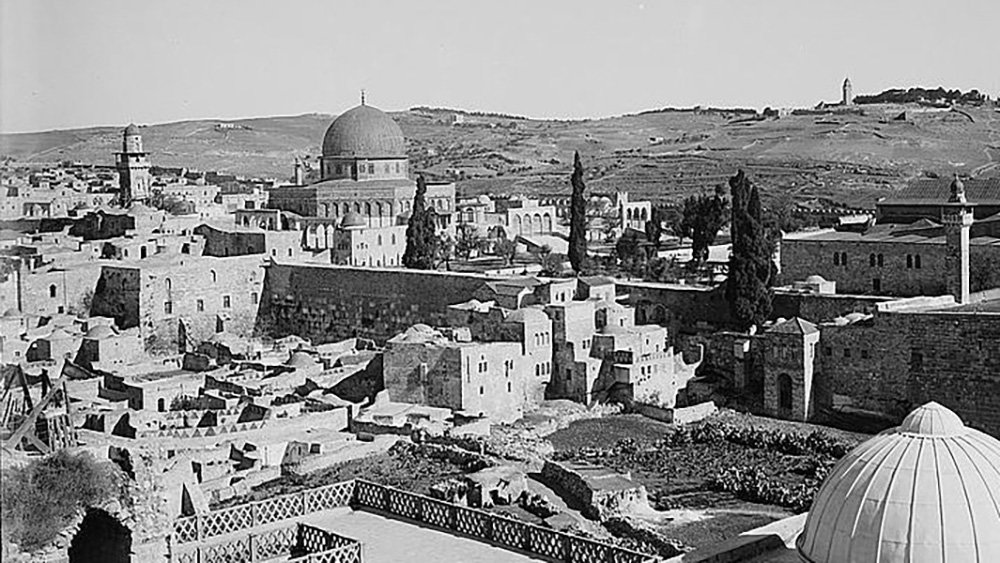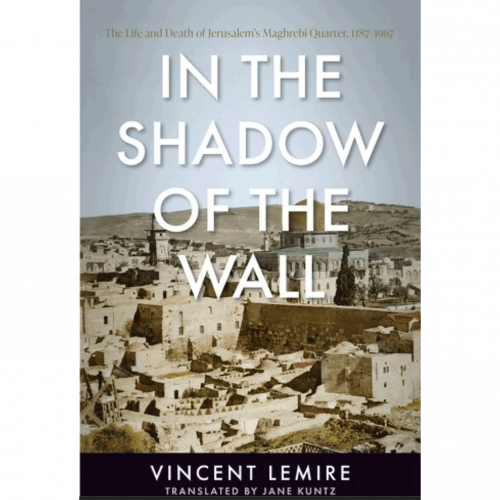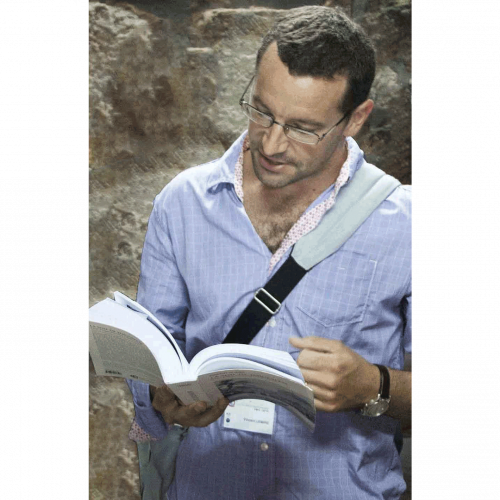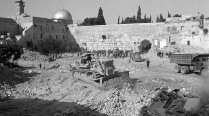In the Shadow of the Wall: The Life and Death of Jerusalem’s Maghrebi Quarter, 1187–1967, by Vincent Lemire. Translated by Jane Kuntz. Stanford: Stanford University Press, 2023.
The Moroccan Quarter of Jerusalem’s Old City had been an Islamic endowment (Waqf Abu Midyan) for almost 800 years when it was razed by the Israeli army within hours between June 10 and 11, 1967 (see The Destruction of Jerusalem’s Moroccan Quarter: From Centuries-Old Maghrebi Community to Western Wall Prayer Plaza). Today, most visitors to its former location are unaware that the quarter ever existed; in fact, it had been home to a vibrant and diverse community that Israel expelled and rendered homeless in mere hours. In its place, Israeli authorities installed the expansive Jewish prayer plaza across from the Western/al-Buraq Wall, giving easier access to a larger number of Jewish visitors to Judaism’s holy site while in the process erasing centuries of Arab, Islamic history in the space, both physically and from historical memory.
Drawing on a range of sources, including consular reports, archival records (waqf, Ottoman, Central Zionist, and Jerusalem municipal, among others), memoirs, newspaper accounts, unpublished photographs, and interviews with eyewitnesses, French historian Vincent Lemire sifts through the evidence to produce an authoritative history of the erased quarter. In the process, Lemire—who is Associate Professor of Contemporary History at Gustave Eiffel University, Director of the Open Jerusalem European Research Council project, and Director of the French Research Center in Jerusalem, as well as author of several previous books on Jerusalem’s history1—reveals why the quarter matters and why it is important that we understand the manner in which its destruction was carried out and immediately erased from view. Indeed, readers who wonder why anyone would bother to write a history of a place that no longer exists would do well to remember the words of US novelist William Faulkner: “The past isn’t dead. It isn’t even past.” The quarter may have been razed, but it still makes its former presence known, in the poignant way that the past demands to be acknowledged.
Established to meet the needs of pilgrims from western North Africa (a region called the Maghreb), what became known as the Moroccan or Maghrebi Quarter was supported by the rich lands of ‘Ayn Karim, a village west of Jerusalem that provided as much as 40 percent of the waqf’s disposable income.2 The quarter was both respected and protected during the Ottoman period, cited by name in imperial firmans, Lemire notes. The waqf lost that protection during the British Mandate—a time Lemire describes as one of “extreme fragility,” when it “had to deal with new institutions that were less positively disposed toward it.”3 (The quarter’s Ottoman and mandate histories are covered in chapters 1 and 2.) By the end of the Nakba, ‘Ayn Karim was ethnically cleansed, and the Moroccan Quarter was dealt a decisive blow.
The status of the quarter between the 1948 and 1967 wars is described in chapters 3 and 4. France stepped in to fill the administrative vacuum, but its involvement in the affairs of the quarter after 1948 came to an end in 1962, with its defeat in Algeria’s War of Independence.
The Zionist movement had had interest in the Moroccan Quarter since at least 1912, and after 1948, it was firmly in the crosshairs of the new and aggressive state. By April 1963, Lemire tells us, the residents of the quarter “found themselves totally isolated” and were “living on borrowed time.”4
Lemire tells the harrowing story of its demolition in chapter 5, “Expel and Demolish: History of a Political Decision (June 1967).” The speed with which an action involving many players (army commanders, engineers, bulldozer operators, stunned residents, and others) was carried out makes clear that it was “a scheduled and planned operation, and not at all from some spontaneous initiative”5 concocted in the heat of battle by some hot-headed army commander—in other words, it was the implementation of a political decision taken at the top.
The rubble was still being cleared when on June 14, when Jewish Israelis flocked to the Western Wall to celebrate the Jewish holiday Shavuot. What remained from the quarter is a ramp, and when it gave way as a result of heavy rain, snowfall, and an earthquake several decades later, it became an international issue involving UNESCO, the United States, and Israel.
To reconstruct the history of an act of ethnic cleansing that resulted in the death of at least one resident of the quarter and the expulsion and scattering of 650, Lemire turns primarily to Israeli sources, among them the personal papers of Meron Benvenisti (the deputy mayor of East Jerusalem between June 1967 and January 1972), municipal records, government archives, personal testimony, and the photographic evidence provided by Gilles Caron, one of the first to enter the Old City during the 1967 War. Lemire uses both his published and unpublished photographs in reconstructing a timeline of the quarter’s erasure.
The postmortem history of the quarter is the subject of chapter 6. Lemire tackles the subject in terms of the diplomatic response to the destruction, the approach to reparations as a way of containing the fallout, and finally, the manner in which the last demolitions in the quarter took place over time and in full public view. In other words, he examines “the lengthy procedures that preceded the destruction of the neighborhood’s very last block of houses, Dar Abu Saud, in 1968–69” to offer insights about the earlier demolitions.6
The book ends with a discussion of the factors that enabled a shroud of silence to cover the once-thriving Old City quarter. They include France’s loss of standing as protector of the quarter after Algeria’s independence, the latter’s preoccupation with more pressing concerns in the early years of its independence, and Israel’s determination to settle the matter quickly by offering reparations to individuals but not to the group of expelled residents.
By studying the history of a place that no longer exists, Lemire demonstrates, our understanding of the history of Jerusalem is enriched. The need to find a way to study a place that has been destroyed and denied has led to a reliance on a range of archival sources. In turn, the sources have increased our understanding of Jerusalem during the Ayyubid, Mamluk, and Ottoman periods, the importance of the waqfs and the role they play, the relationship between the Old City and the hinterland, and the value of local administrative sources in shedding light on the internal dynamics of a city.
Indeed, it is impossible to read about the razing of a historic part of the Old City more than half a century ago without hearing echoes of Israel’s ongoing moves to ethnically cleanse Sheikh Jarrah and Silwan of its Palestinian residents. Likewise, it is impossible to read this book without seeing in the fate of the Moroccan Quarter a first act in Israel’s playbook for the eastern part of the city that it occupied in 1967—one it has been executing with steely determination for the last 56 years and counting, like the playbook it previously executed within its 1948 borders.
Notes
His other publications include La Soif de Jérusalem: Essai d’hydrohistoire (1840–1948) (Paris: Éditions de la Sorbonne, 2011); Jérusalem 1900. La ville sainte à l’âge des possibles (Paris: Points, 2016), translated into English, Arabic, Hebrew, and Chinese; Jerusalem, histoire d'une ville-monde des origines a nos jours: Histoire d'une ville-monde, des origines à nos jours (Paris: Editions Flammarion, 2016); and with Mathilde Larrère, Félix Chartreux, Maud Chirio, and Eugénia Paleraki, Révolutions – Quand les peuples font l'histoire (Paris: Belin, 2017).
Page 89.
Pages 69, 70.
Page 177.
Page 180.
Page 231.




